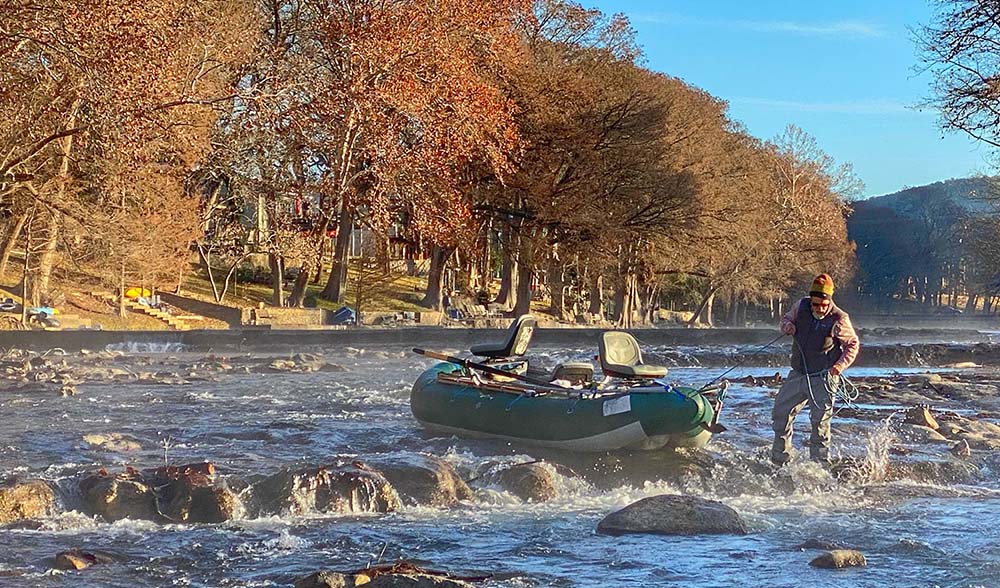Be Safe When Fishing the Guadalupe River

Safe Wading on the Guadalupe River Tail Water
Safe wading in any moving body of water depends on the experience, knowledge and judgment of the individual. The Guadalupe River can be particularly challenging to wade due to the numerous channels and groves that have been worn into the streambed. It is not uncommon to be standing in water that is knee deep or less, and within one to two steps, have water that is over one’s head. A wading staff is recommended for all anglers, especially those not familiar with the river. Using the wading staff as a probe to measure the steps ahead protects many anglers from taking an unfortunate step.
| Flows (cfs) | Rading | Description | Safe Wading Depth* | Notes on Wading & Floating |
|---|---|---|---|---|
| >100 | Low | River flows slightly in areas where there is changing elevation. | Waist to Chest | Very Easy to wade. Difficult (too low) for rafting. Okay for canoe and kayak but you may have some shallow water to navigate/walk through. |
| 100-250 | Average | Current is noticeable in pooled areas. Riffles and runs are running. | Waist to Chest | Inexperienced waders use wading staff. Good flows for floating above 150 cfs. Okay for rafting, may have some shallow areas to navigate. Good for beginner canoe and kayak paddlers. |
| 250-350 | Above Average | Defined current running through smaller pools. Slight current running through larger pools, especially in bends of the river. | Waist | All waders should have wading staff. Choose crossing carefully. Fine for Rafting. Very good for all but beginner kayak and canoe paddlers. |
| 350-550 | High | Current is flowing well through large pools. Riffles look more like small rapids. | Thigh to Waist | Unsure waders are better to float than wade. All anglers should use a wading staff. Only cross the river out of absolute necessity. Good for rafting and intermediate to advanced kayak and canoe paddlers. |
| 550-650 | Very High | Current flowing very well in the deepest parts of pools and rapids have become treacherous. | Ankle to Thigh | Wading for only experienced waders, with a wading staff! Do not try to cross the river. Great flows for rafts but upper limit for kayak and canoe. |
| 650< | Dangerous | Rapids can range up to Class III, but more typically I-II. | Bank to Ankle | Recommend only float trips via raft. Flows above 1500 cfs are for advanced paddlers. Flows above 3000 cfs by expert paddlers or on guided trips. |
*Safe wading depth is merely a general recommendation for average waders. Be honest in assessing your wading skills before putting yourself in a situation that you will come to regret.
It All Started in the 60's With Lone Star Beer & Some Rainbow Trout
Who controls the flows?
There numerous agencies and groups that have a say in the amount of water released from Canyon Dam, with four agencies having direct control over the amount of water being released from Canyon Dam:
- Army Corps of Engineers (USACE) owns and operates Canyon Dam
- Guadalupe Blanco River Authority (GBRA) owns the water held in Canyon Lake as well as the hydroelectric plant located at Canyon Dam
- Federal Energy Regulatory Commission (FERC) is the licensing agency for hydroelectric power projects in the US
- Texas Commission on Environmental Quality (TCEQ)
Additional stakeholders include:
- Guadalupe River Trout Unlimited (GRTU)
- Comal Water Oriented Recreation District (WORD)
- Various owners of senior water rights located downstream of Canyon Lake.
For more detail, please see: https://wordcc.com/guide-to-release-levels/
